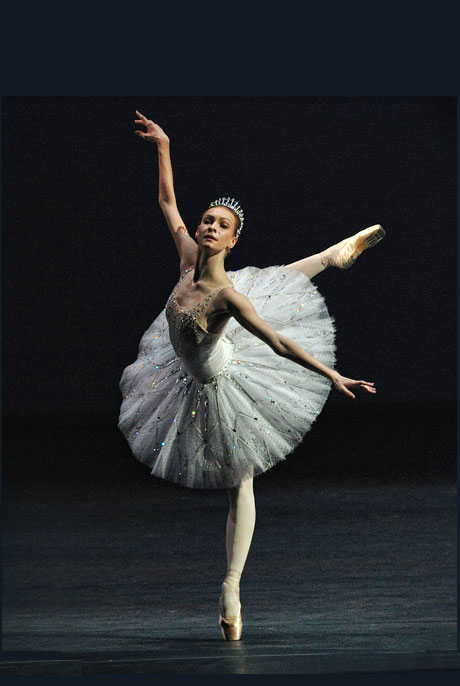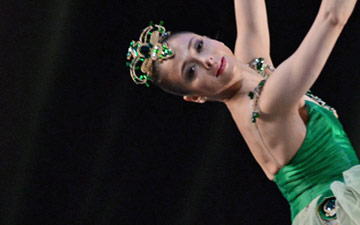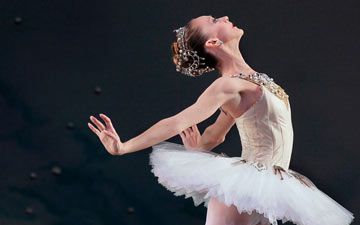
© Foteini Christofilopoulou. (Click image for larger version)
Bolshoi Ballet
Jewels – Emeralds, Rubies, Diamonds
London, Royal Opera House
12 August 2013
Gallery of Pictures by Foteini Christofilopoulou
www.bolshoi.ru/en
Details of the Bolshoi London season
When Balanchine choreographed Jewels in 1967, he would not have had the Bolshoi in mind. He was harking back to the ballet traditions that had formed him – the Imperial splendour of the Mariinsky theatre and the romantic elegance of the Paris Opera – and linking them with the showbiz brashness of New York. When the Kirov (now once again the Mariinsky) Ballet set about discovering New World Balanchine in the late 1990s, they understood where he was coming from. Their dancers assimilated his technical demands, thanks to dedicated coaching, with a trust and openness foreign to the Bolshoi.
So when the Bolshoi brought their recently-acquired production of Jewels to the Royal Opera House this summer, in lieu of Wayne McGregor’s cancelled Rite of Spring, they faced comparisons with the Mariinsky 1999 production, as well as the Royal Ballet’s. The Bolshoi corps is still coming to terms with Balanchine’s accounts of styles they don’t know: French in Emeralds, American in Rubies. You can sense their relief when they reach Diamonds, with its familiar Russian themes in Tchaikovsky’s Symphony no. 3. (Emeralds and Rubies were staged by Sandra Jennings, Diamonds by Merrill Ashley and Paul Boos, authorised by the George Balanchine Trust.)

© Foteini Christofilopoulou. (Click image for larger version)
New designs by Alyona Pikalova are respectful, keeping the general effect of the 1967 originals. A golden doiley frontcloth is regrettable. Velvety grey drapes along the wings supposedly recall the lining of a jewellery box, with appropriately-coloured ‘stones’ at their tie-backs. Glass panels at the rear of the stage shine green or red, sometimes distractingly when the light catches them. They are replaced by starry twinkles in a night sky for Diamonds. Redesigned costumes by Elena Zaytseva observe the same shapes and colours as Karinska’s City Ballet ones: long skirts for Emeralds, short tunics for Rubies, white tutus for Diamonds, all gleaming with theatrical gems.
Emeralds is always a problematic opener for this plotless ballet in three acts. A vision scene usually comes in a middle act, once the audience’s attention is fully engaged. Here, skeins of nymphs or ondines drift to Fauré’s dreamy music, while two leading ladies lose themselves in their own fantasies. Evgenia Obraztsova (formerly of the Mariinsky Ballet) preened herself, admiring her arms and wrists, smiling delightedly. Her partner, Vladislav Lantratov, ran around her, catching her as she swooned. Anna Tikhomirova, the ballerina with the walking motif on tip-toe, smoothed out the phrasing of her steps, making them bland instead of strangely spell-bound. In the trio with Igor Tsvirko, dark-haired Ana Turazashvili relished the quirky pointwork, recognising that Balanchine was commenting on the music’s wayward pulse. Emeralds is so much odder, so much more interesting than it looks on first acquaintance.

Ana Turazashvili in Emeralds, from Jewels.
© Foteini Christofilopoulou. (Click image for larger version)
Rubies socks itself to the audience from the start, with a line-up of saucy chorines like paper-doll cutouts. Bolshoi ladies of the corps de ballet seem never to have seen chorus girls in old movies, let alone on stage. They had no idea what they were sending up to Stravinsky’s jazz-inflected Capriccio. The two ballerinas, Ekaterina Krysanova as the mini-siren, Ekaterina Shipulina as the brazen good-time girl, did know what they were doing. Krysanova was subdued to start with, then got the bit between her teeth, enjoying being a bad girl. As supple as a pussycat, unafraid to be off-balance, she could eat her playmate, Dmitri Gudanov, for breakfast. He was too preoccupied trying to deal with her for what should be a carefree role as leader of the gang of bouncy boys.

© Mikhail Logvinov. (Click image for larger version)
Diamonds has only one ballerina – Balanchine’s feminine ideal, worshipped by her male consort. Tchaikovsky’s Symphony no 3 was written just before his Swan Lake score, with premonitions of that ballet, and of The Sleeping Beauty in the polonaise final movement. Mysteriously, there are echoes of the hunting horns in the Fauré music used for Emeralds. The ballerina shares Odette’s conflicting urges to flee and return for reassurance. She is also Nikiya in the Kingdom of the Shades: approachable but unattainable, aware how evanescent love can be.The Bolshoi’s glorious rising star, Olga Smirnova, was imperious and yielding, leaning back into Semyon Chudin’s arms in temporary surrender. She used the extravagance of her high extensions to good effect, acknowledging his strength in retrieving and supporting her. Instead of the extreme legato of the Mariinsky’s Uliana Lopatkina in the role, she varied her tempi, holding still at the end of sequences. Still very young, she has more nuances in her upper body than the Bolshoi’s senior ballerina, Svetlana Zakharova (who initially danced Diamonds with the Mariinsky before moving to Moscow).

© Marc Haegeman.
Impeccable in the pas de deux, Smirnova’s carriage was marred by a tightness in her neck and shoulders when she embarked on tricky diagonals in her solo variations. Chudin was elegant throughout, kissing her outstretched hand in adulation at the end of the spun-silk pas de deux. Hushed into silence, the audience later burst into applause for his admirably controlled turns in second, ending in multiple spins in place – far from flashy. The finale, stage filled with white tutus, everyone bounding in unsion, is an infallible Balanchine applause machine.
The Prodigy – Olga Smirnova from Michael Sugrue on Vimeo.
The most heartfelt ovation came towards the end of the curtain calls, when the leading dancers drew Sergei Filin, their damaged artistic director, onto the edge of the stage. It was his first appearance with the company since his prolonged stay in a German clinic, where his acid-burned eyes are still being treated. During Jewels, he had been seated in the stalls circle, wearing dark glasses. It was evident from the assistance he needs that he cannot see to walk unaided. With dignity and pride, he bowed to his company and the Opera House audience. After further medical help, he hopes to return to Moscow and the Bolshoi in September.

















You must be logged in to post a comment.